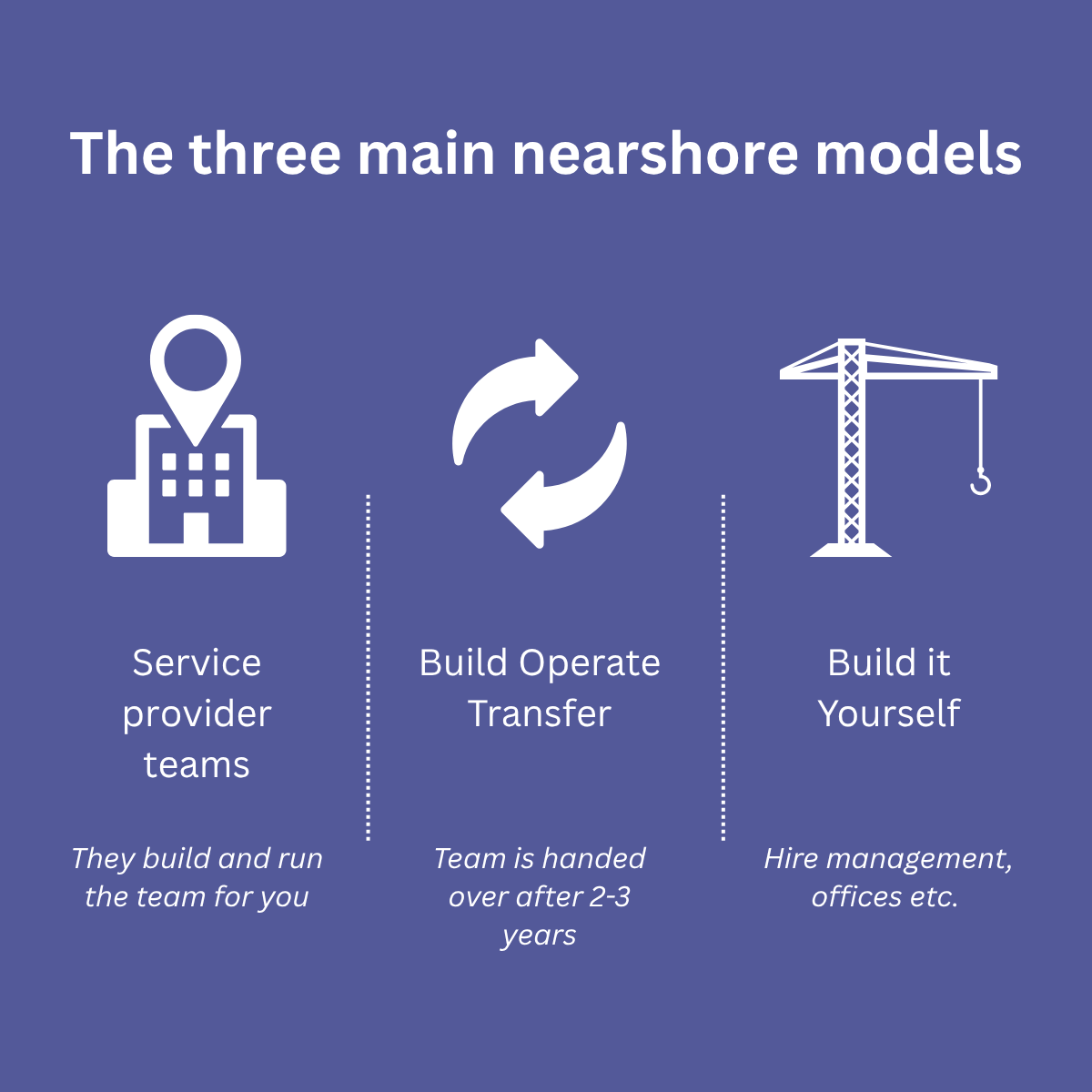Starting a nearshore software development center with freelancers
The global work shift in 2020 strengthened the practice of hiring remote software engineers from nearshore locations. Some companies who started riding this wave later opened their offices and kicked off official delivery centers, tapping more talent from the Eastern European region.
This is one of the natural ways of starting such operations. A more traditional way we've seen through the years is partnering with a local service provider and gradually building a team within their company, which eventually gets bout off or transitions to another company. A build, operate and transfer model.
A third way that has also proved to work is to start the delivery center from scratch. Research the market, choose country and city, pick your office, administration capacity, and the most important one - find the leader of the operations. A local person, who knows the market and has the capabilities to scale it.
These are all good ways to consider expanding your operations and you can choose a mixture of them. But they all come at some cost. At the end of the article we've prepared a table, comparing all three methods when it comes to complexity, price, time to launch, and internal effort spent.
What we've recently implemented is starting the journey of opening nearshore operations by hiring freelancers. One of our UK-based customers wanted to explore all options they had for setting up nearshore operations in Eastern Europe. Being a small, but quickly growing company they were thinking of the best approach to go forward. If you are an established organization with a budget, stable inflow of customers, projects, and cash you have a lot more freedom to choose the best approach. However, in this scenario they needed a fast, less costly and less risky alternative.

Here's what to consider in implementing this model.
Select a few projects, where contractors/freelancers can join in and provide external to the team value. Especially focus if the budget of the project is unclear and/or short-term. Put extra focus on positions, that may not be the core for your team. For example, if you are a Java-based organization, but due to some project specifics you need a .NET expertise. An alternative approach is to use freelancers when you have a project, that needs to be quickly started, but you don’t have internal manpower.
Trust the identified roles with a preferred supplier of freelance resources in the region you are interested in. Go into extensive detail when defining the technical and non-technical criteria, budget, scope, and other key characteristics so the matching process includes everything needed for the closest match. The goal is to offload recruitment efforts to the partner and only receive quality profiles.
Make sure to adjust your interview process if needed. Having multiple-step interviews might not be needed, especially when you are looking for senior freelance resources. You are hiring specific resources for specific needs.
Evaluate quickly their contribution from technical perspective, but also cultural fit and overall performance. It is best to test with 3-4 roles for better representation. Should you be happy with performance start thinking about tapping more of the market.
We advise having discussions with your team about the initiative and getting support from key managers.
Let's pause on the process and discuss what your potential benefits are so far.
No bench management.
Especially if the roles are non-native in terms of expertise to your organization and your services and the budget stops you are left with no bench. The freelance model allows for quicker project start and stop. Freelancers are hired for a specific term with a reasonable time to transfer knowledge if needed. But essentially, when the project is no longer live you don't continue the bench payroll. It's worth mentioning that the quick onboarding part is a lot harder if you don't have a partner who has pre-vetted and matched the specialists, according to your specific project needs. And this is where the second benefit is.
No heavy market research investment.
You don't need to understand what the best recruitment channels and methods are to reach the local talent. Your local partner will take care of that. They will also make sure to understand the non-technical aspects of the role and select only the people who would fit. For example, if you need a more customer-facing consultancy role.
Less internal energy and overhead spent in the process
Besides selecting the right partner you won't have to hire offices, research employment laws, open a local company, do employer branding etc. You can build you brand later and hire administrative power, for this exercise you rely on your partner to reach to the right people and position you in the right way.
Another major time-cutting factor is sifting through all Human Cloud noise. The freelancers' service partner should guide you through the recruitment noise you will otherwise receive if you open similar roles on your own. On average, we see 400+ candidates for lucrative software development positions opened on LinkedIn for remote work. The time to review the profiles on its own will eat-up time you can put into more strategic tasks.
Keep the margins where you want them.
Yes, freelancers seem to be more expensive at first sight, but if you look deeper, you omit a lot of expenses, that otherwise eat from your margins - equipment, office, benefits, etc.
No loss of revenue (for professional services companies).
The freelance model by itself provides the option for a quick start of specialists. In case you miss internal capacity to staff your projects this is a great option not to lose billability. The initiative of opening a nearshore development center with freelancers will not provide additional benefits in this regard, but this is a great case to test the model.
Get an easy and quick taste of the market.
There are no two people alike. But you can get a feeling of the general level of the market. Especially with a local partner, you can tap into a market of seniors, who would not change their permanent job in an unsecured market. Furthermore, this option allows you to quickly assess the region. Usually, setting up operations on your own takes from 9 to 12 months with research and implementation. Using a service provider usually takes between 6 and 9 months, depending on the size. Our experience shows that in a matter of 3 months you can have a number of freelancers working and already assess cultural, technical and fit with all other relevant aspects.
How do you move forward after testing the model?
If you decide to start hiring your permanent team and set up your “nest” in the preferred location here’s what you will benefit from this model.
You can switch freelancers to permanent employees. Some partners focused on providing freelancer services provide the option to convert into employees after a specific time. Especially if you’ve already worked with the specialists already for some time and you feel this is the right fit.
Having worked with freelancers from the region and your supply partner you can rely on more expertise on office, location, relevant benefits, and generally what competition is like on the market.
You are free to ask the freelancers for referrals. They’ve already assessed your company. You have built some trust with them, it is natural they would refer great peers for permanent roles. In addition, your name has probably already circulated with their testimonials.
|
|
Cost |
Time to launch and operations |
Internal effort spent |
Complexity |
|
Fully in-house implementation |
High, considering you pay all costs from the very beginning |
6 to 9 months |
High |
High |
|
Using a service partner/ Outsourcing partner |
Moderate, using partner’s infrastructure and resources |
1 to 2 months average for of 2 teams |
Assessing the right service partners, usually including serious procurement research |
Mid, highest complexity point would be to register approval for such outsourcing deal |
|
Using a freelance partner |
Very low, especially for the initial test period. You pay only for worked hours |
First hire within 2 weeks. 2 months to reach 10+ delivering freelancers |
Only assessing freelance partner that can cover and advise on the entire region |
Low, with pay-as-you-go model you can have very low complexity of implementation |
Whether you have or haven’t considered opening a nearshore software delivery center in Eastern Europe now you have another option, which is low in risk, price, time, and complexity to implement. It is a simple as hiring an external freelancer to fill-in project-specific roles and actually do a job that is required for your business. But including a trusted partner can help you assess a long-term strategy of lowering costs and expanding your candidate reach to a whole new location.


